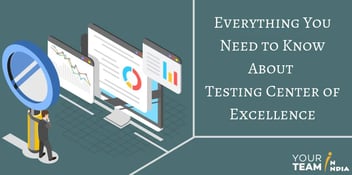Innovation drives success for organizations today, especially in competitive environments.
Managing the business process involves planning, management, analysis as well as integration. And all this has to be executed continuously.
Well, the testing teams are always under pressure to decrease development time without compromising quality.
Traditional testing methods fail as they just cannot keep up. The challenges in constantly delivering software that is time-bound, robust, and efficient.
All this has further prompted more and more organizations to lean toward the idea of establishing a centralized testing service (TCoE).
But before investing in quality, here are the following things an organization should consider:
- Rush to hit release dates with little regard for quality
- Allow numerous critical and severe defects into production
- Have a long backlog of known production issues
- Lack of meaningful quality metrics and KPIs
What is the Testing Center of Excellence?
Test Center of Excellence works on an approach like people, process, and technology that work together to build quality within the enterprise.
IT leverages different tools according to the company’s requirements, processes, techniques, and methodologies to deliver market-ready applications.
Testing Center of Excellence governs how the testing organization engages and delivers services to the enterprise. This is a strategic approach that comprises of:
- Established objectives (that are understood, agreed upon and documented)
- Well defined processes (Unambiguous)
- Governance mechanism
- Multi-discipline skill sets (You need a team with a diverse set of skills, expertise, and experience)
- Common tools and technologies (software and strategies)
The benefits of establishing TCoE are plenty. It eases the effort for the teams to evolve existing testing services.
Thus makes the team more agile and able to deliver new services with higher quality.
All this promotes a culture of quality and improves delivery confidence within the company thereby boosting morale.
Also, it leads to faster time to market adding to the ability of your organization to be more competitive.
In addition to this, it reduces and optimizes the cost and create tighter alignment within the organization.
Reasons it is Time to Evolve Your Test CoE
Undoubtedly, the testing Center of Excellence (CoEs) has transformed quality assurance for business globally.
But as times are changing, new pain points have started to emerge.
Even the best CoEs are finding traditional tools and tried and true frameworks simply don’t mean keeping pace with today’s application development.
The disconnection doesn’t mean it is the right time for the Testing Center for Excellence to be tossed aside.
This is high time to make some smart moves in order to address the changing landscape. When that is done, you can impact and ensure your relevance for years to come.
Reason 1: Technology Shifts that Impede Sharing and Reuse
The agile developers you hire are taking the help of open-source technologies and tools in order to support the rapid-fire pace of their work.
But most of the Testing Center of Excellence relies on the proletarian platform.
This means, every time a Quality Analyst encounters a new development project, they have to reinvent the wheel from the development environment to the performance testing center.
There is no way to share components or plans and this is a very expensive inefficiency.
Reason 2: Testing Bottlenecks that Leads to Undetected Performance Issues
This is true that the company’s Agile development team re-adopting “early and often” testing practices.
Most of them rely on the CoE for performance testing. But the pace, as well as the demand for the resource, are quite overwhelming, making it daunting to keep up in the industry.
As a result of this, the defects and performance issues have to take a backseat and this goes undetected with poor quality apps making a way to customers.
Ultimately, the organization’s brand image and bottom line can suffer drastically.
Reason 3: Delays in Software Delivery
When your in-house QA team lacks visibility into different Agile development projects, it may lead to a lot of trouble.
There are many production delays especially when the resources are unavailable and are unassigned at the right point of time.
Time to market can expand and the cost may soar. In this case, TCoE services help to bridge the gap.
Reason 4: Lack of QA Framework for Agile Development
Your software development team or QA team lacks comprehensive quality practices of CoE.
Many ignore simple things like documentation. As a result of which there are quality issues that occur and fixes become more time-consuming.
Also, there is a lack of QA framework impacting the performance assurance testing private cloud environment as the Agile team lacks access to extensible tests via RESTful APIs.
Reason 5: Keeping Up with the Trends
It is a possibility that your current in-house QA team may not be able to cope up with the trending technologies in testing.
However, the right TCoE solution can help companies to stay updated with new technologies and trends.
All this helps in sharing knowledge by training the team across all the levels within the company.
Partnering with the experienced TCoE team ensures businesses can gain a competitive edge and respond quickly to new business opportunities.
Reason 6: Continuous Improvement Hindrance
Due to the lack of open-source ready software test management platforms, it becomes challenging for the QA team of your company to support a delivery model.
Agile development teams don’t perform regular performance assessments.
As a result of this, it becomes challenging to launch continuous quality improvement initiatives helping the in-house team aim for higher performance at the top of their game.
Well, today it is time for a paradigm shift.
To address the app development challenges while ensuring the relevance of CoE, it is the right time to broaden your scope.
With a simple yet smart move, you can take help from an experienced TCoE team so that you reach new heights.
Recommended Read: Why Testing Center of Excellence is Important for Effective Software Outsourcing?
Challenges When Implementing TCoE:
- Obtaining organizational commitment may be an uphill battle and it is most definitely a commitment!
- The investment is in time, effort, and money.
- Setting the right direction thereby prioritizing the effort and tasks while implementing a TCOE are challenging.
A Practical Approach to Establishing a Testing Center of Excellence
When any company takes a strong decision to build a Testing CoE, there are a few fundamental steps that have to be considered.
Well, you can take help from an outsourcing company that has experience in delivering TCOE services
It can take by the internal QA team or with assistance from an independent testing partner:
Step 1: Assessment of the present scenario and the testing practices
Conduct a Survey
This will definitely help you better understand how your organization ensures quality. There are a few things that you should be sure of doing:
- Focussing on people, processes and technology
- Solidifying objectives
- Identifying stakeholders
- Set a budget
- Obtaining executive management
The earlier you do that, the better.
Step 2: Perform a Detailed Assessment
By “detailed” assessment we mean the analytical process that helps in better understanding where you are and where you want to be and how to reach there.
All this is completely focused on people, processes, environment, and its solution. And it adds value if an outsourcing form is performing this assessment.
Identifying the loopholes
- Setting roadmap for implementation of the past
- Developing a governance model
- Identifying the important aspects like framework, tools, processes etc.
- Create communication channels
- Implementation
Step 3: Work as per Objectives while Creating a Roadmap
Before starting the task and conceptualizing the idea of the Testing Center of Excellence, it is crucial to have the right vision.
The objective has to be communicated across the organization so that everyone agrees and endorses the idea.
This will also help to move in the right direction.
Make sure you have the best-implemented team.
There has to be a dedicated outsourcing team that knows how to move ahead with the development responsibilities for the organization.
Well, the best practices come from the expert QA team that knows how to put together a seamless implementation plan.
Partnering with the offshore development company is a recommended approach so that the complete process is flawless
Step 4: Design and Build Excellent TCoE
While designing, there are two must-do things:
Put in place the leadership structure including an executive sponsor and business subject matter experts.
All you have to do is to define the processes for continuous improvements like lessons-learned and best practices.
No one wants to repeat the same mistakes over and over again.
Step 5: Have the Right Tools
The complete industry is flooded with plenty of tools that have become quite popular.
The credit goes to the idea of open innovation as the testing and development scenario us revolutionizing.
But it is the call of the company as they have to decide whether to take the commercial path or the open-source way.
For instance, commercial tools are considered for normal updates and training modules.
If you feel your organization doesn’t have a strong testing team, it is better to go the commercial way.
All this requires a training module for various upgrades and versions.
Step 6: Consider the Approach
In this development scenario, there is a critical scenario to involve.
This will save huge bucks for the company as if defects are found post-production.
The core objective
This will save the organization big bucks, as if defects are found post-production, the costs of resolving them are bound to soar.
TCoE has to be designed in a way where there are a collaborative effort and the responsibility of ensuring quality is shared by all.
The core objective should be to address the requirements of the end-user and work accordingly to ensure the same, with cost-effectiveness, ensuring faster time-to-market.
Step 7: Adopt the TCOE across the enterprise
In this adoption across the enterprise, you have to prioritize your projects. There is no use if you don’t have to put this excellent testing center of excellence in place and your organization does not follow it.
Communicate the abilities, measure, and track results, and don’t forget to share the wins. This is definitely a morale booster.
Step 8: Automate: Keeping it Simple
Automation and continuous improvement is the primary key for successful quality assurance.
There are a lot of advantages that come to the table with standardized test automation. The best are the tangible results.
You have to be very careful regarding the processes, testing tools as well as methodologies.
Also, you should be able to gauge its impact on a particular task and decide on its value in the Testing Lifecycle
The Final Note
The right implementation of TCoE can be a major challenge for a startup as well as larger and established teams.
However, it is a worthy task as there are plenty of benefits that it has to offer in the long run.
Two of the most important ones are an increase of overall quality and a reduction of delivery time.
With the optimization of tasks that a Testing Center of Excellence ensures, this becomes a remarkable framework to be considered.
Especially when there is a lack of quality or the process is confusing or inconsistent.
Ultimately, partnering with the right company that offers TCoE and its implementation will lead to a reduction of costs and time between deployments with higher quality deliverables, guaranteed by a highly competent and trained team.






